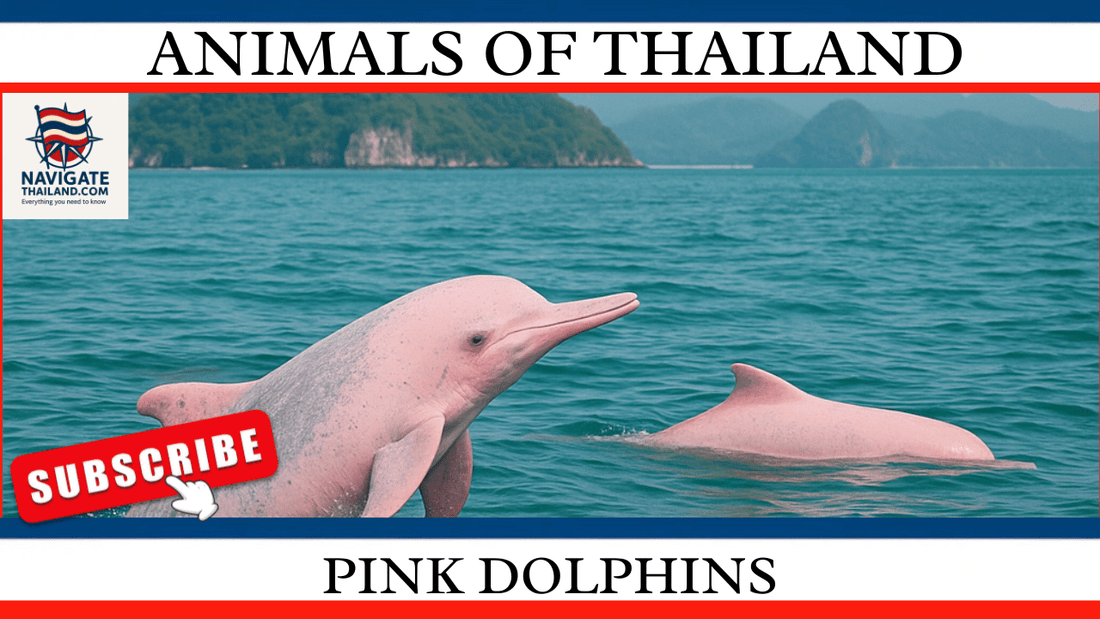
Pink Dolphins in Thailand: Everything You Need to Know
Share
Pink dolphins are one of the most enchanting and rarest sights in Thailand. These fascinating creatures, found in the waters off the southern coast, captivate both marine biologists and travellers. With their unique pink hue, they stand out from the more common grey dolphins, adding to Thailand's rich marine biodiversity. But what makes these dolphins pink? Where can you see them? And what are the ongoing efforts to protect this rare species? This detailed guide will explore everything you need to know about pink dolphins in Thailand, including their habitat, behaviour, conservation efforts, and where you can catch a glimpse of these magnificent creatures.
Why Are They Pink?
Pink dolphins in Thailand belong to the species known as Indo-Pacific humpback dolphins (Sousa chinensis). While not all dolphins of this species are pink, some individuals develop a distinct pink hue, making them an unusual and magical sight. So, why are these dolphins pink?
1. Biological Factors: Pink dolphins are typically born grey, like other dolphin species. As they mature, they lose the pigmentation in their skin, which can cause some individuals to appear pale or pink. The pink colour is especially visible in older dolphins, whose pale skin allows the blood vessels underneath to show through, giving the dolphins their characteristic pink appearance.
2. Blood Vessel Expansion: The pink hue can also be attributed to the dolphins’ ability to regulate their body temperature. When these dolphins are active or excited, they expand the blood vessels near the surface of their skin to release heat, making their skin appear even pinker. This thermoregulation process is similar to how humans blush.
3. Environmental Factors: The unique environment where these dolphins live also contributes to their pink colour. Pink dolphins are typically found in warm, shallow waters near river mouths, where the water is rich in minerals. This environment can help enhance the dolphins’ pinkish hue over time.
Where Can You See Pink Dolphins in Thailand?
If you want to catch a glimpse of pink dolphins in Thailand, you’ll need to know where to look. These dolphins are not found everywhere, but there are a few key spots where sightings are common.
1. Khanom, Nakhon Si Thammarat: Khanom is the most famous location for pink dolphin sightings in Thailand. Located on the Gulf of Thailand, Khanom offers pristine, calm waters where these dolphins are often seen swimming and feeding. Numerous boat tours are available in the area, with early morning trips providing the best chance to spot pink dolphins in their natural habitat.
2. Samui Archipelago: The waters surrounding the islands of Koh Samui, Koh Phangan, and Koh Tao are also home to pink dolphins, although sightings are less frequent here than in Khanom. You can join eco-friendly boat tours that specifically seek out these dolphins, making the Samui Archipelago another excellent place to try your luck.
3. Surat Thani: Just north of Nakhon Si Thammarat, Surat Thani is another popular region for pink dolphin sightings. Local fishermen and tour operators offer dolphin-watching excursions that take visitors out to areas where these rare dolphins are often spotted, particularly near river mouths.
4. Mu Ko Ang Thong National Park: Off the coast of Koh Samui lies Mu Ko Ang Thong National Park, a protected area known for its diverse marine life. Pink dolphins are occasionally spotted in the waters surrounding the park, particularly near coral reefs and islands where they come to hunt for fish.
These are the best spots in Thailand to catch sight of pink dolphins, but sightings can never be guaranteed. However, booking a responsible and eco-friendly dolphin-watching tour will give you the best chance of encountering these rare animals in their natural environment.
The Habitat of Pink Dolphins
Pink dolphins prefer shallow, coastal waters, usually found near river mouths, estuaries, and mangroves. These areas provide an abundant food supply and a safe environment for raising their young. The Gulf of Thailand, where most pink dolphin sightings occur, is home to many such habitats. The warm, brackish waters in these regions provide the perfect conditions for these dolphins to thrive.
These dolphins generally inhabit waters less than 20 metres deep, which allows them to navigate and hunt efficiently. While they are comfortable in saltwater, they often venture into fresh or brackish waters in search of food. Unfortunately, the dolphins' preference for coastal regions puts them in direct conflict with human activities, such as fishing, coastal development, and pollution.
What Do Pink Dolphins Eat?
Pink dolphins are carnivores, with a diet consisting primarily of fish, crustaceans, and cephalopods. Their feeding habits are determined by their habitat, where they hunt in shallow waters rich in marine life. Their diet includes:
1. Fish: Small and medium-sized fish species make up the bulk of the pink dolphin’s diet. They often hunt schools of fish by working together to herd them into confined areas, making it easier to catch their prey.
2. Crustaceans: Pink dolphins frequently feed on crabs, prawns, and other crustaceans found in the muddy waters near river mouths and estuaries. These areas are rich in nutrients and provide an easy source of food.
3. Cephalopods: In addition to fish and crustaceans, pink dolphins also consume squid and other cephalopods. These prey items are more energy-rich and serve as an important part of their diet when available.
The dolphins use echolocation to navigate and locate their prey, a process in which they emit high-frequency clicks that bounce off objects in the water, helping them "see" in the murky depths of their coastal habitats.
Threats to Pink Dolphins
Despite their beauty and uniqueness, pink dolphins face numerous threats that jeopardise their survival. Human activities, in particular, have caused a significant decline in the population of these dolphins in Thailand. Some of the most pressing threats include:
1. Fishing Nets: One of the greatest threats to pink dolphins is entanglement in fishing nets, particularly gillnets. Dolphins can become trapped and drown when they get caught in these nets, which are often left unattended by fishermen.
2. Coastal Development: As more areas of Thailand’s coastline are developed for tourism and industry, the habitats of pink dolphins are being destroyed. Coastal development leads to habitat loss, reduced food sources, and increased human-dolphin conflict.
3. Pollution: Pollution from agricultural runoff, plastic waste, and industrial activities poses a serious threat to pink dolphins. Pollutants in the water can affect the dolphins' health and reduce the availability of food.
4. Boat Traffic: As tourism grows in coastal areas, the increase in boat traffic has become another threat to pink dolphins. Collisions with boats can cause serious injuries or even death, and the noise pollution from boat engines can disrupt the dolphins’ natural behaviours, including hunting and communication.
Conservation Efforts
Thankfully, there are ongoing conservation efforts to protect the pink dolphin population in Thailand. Both government and non-governmental organisations are working to ensure the survival of these beautiful creatures. Some of the key conservation strategies include:
1. Marine Protected Areas: Thailand has established several marine protected areas, such as Mu Ko Ang Thong National Park, which help protect marine life, including pink dolphins. These areas restrict harmful fishing practices and limit human interference in critical dolphin habitats.
2. Eco-Friendly Tourism: Many tour operators in areas like Khanom have adopted sustainable tourism practices, ensuring that their dolphin-watching trips do not harm the dolphins or their environment. These responsible tours raise awareness of the species while also minimising the environmental impact.
3. Research and Monitoring: Marine biologists and conservationists are conducting research to better understand pink dolphin populations, behaviours, and migration patterns. This data is crucial for creating effective conservation plans.
When Is the Best Time to See Pink Dolphins?
The best time to see pink dolphins in Thailand is during the dry season, which typically runs from February to September. During these months, the seas are calmer, and dolphin activity is more frequent. Early mornings are generally the best time for dolphin-watching tours, as the waters are still, and the dolphins are most active during this time.
What Every Tourist Should Know Before Going on a Pink Dolphin Tour
Before setting off on a dolphin-watching adventure, there are a few things you should keep in mind:
1. Respect the Dolphins' Space: It’s essential to ensure that the tour operator follows ethical guidelines. Dolphins are wild animals and should not be chased, fed, or touched. Keep a safe distance to avoid disturbing them.
2. Choose Eco-Friendly Tours: Look for operators that practice sustainable tourism. They should avoid using loud engines that can disrupt the dolphins’ natural behaviour and should focus on providing a responsible wildlife experience.
3. Pack Responsibly: Bring reef-safe sunscreen to protect the marine environment from harmful chemicals, as well as a hat and binoculars for sun protection and better dolphin viewing.
Conclusion
Pink dolphins are one of Thailand’s most enchanting natural wonders. Their rare pink colour, playful nature, and the fascinating environments in which they live make them a must-see for nature lovers and eco-tourists. While the pink dolphin population faces threats from human activities, ongoing conservation efforts and responsible tourism can help protect these remarkable creatures for future generations.
References:
Wildlife Conservation Society (WCS)
Department of Marine and Coastal Resources (DMCR), Thailand
National Geographic
World Wildlife Fund (WWF)
Tourism Authority of Thailand (TAT)
Read more of our Thailand blog series:
Thai Food Guide:Traditional Recipes and Street Eats
Everything Travellers Need to know
Thailand travel ebooks and language guides
Thailand Travel Apparel & Souvenir Gifts
Subscribe to our YouTube channel Navigate Thailand to see our most popular Thailand travel blogs turned into videos:
Navigate Thailand YouTube channel


















































































































































